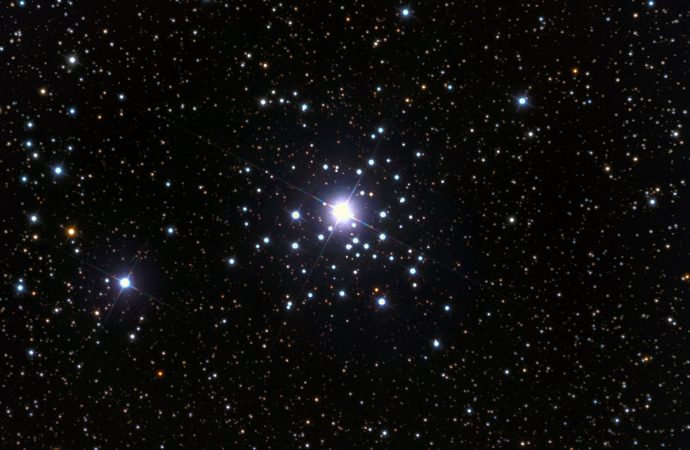The constellation Canis Majoris, the ‘Big Dog’, is home to many fine open clusters of blue-white stars along the stubby Orion Arm of the Milky Way. There are some real gems here, including the modest but delightful open star cluster NGC 2362, a group that hosts some of the youngest-known stars. Centered on the bright star τ (tau) Canis Majoris, this cluster, in a telescope, looks like a large diamond set among many smaller blue-white gems.
With a diameter of 8 light years, NGC 2362 is about the same size as the Pleiades cluster. But it’s about 4,500 light years away, some ten times farther than the Pleiades, so it’s much fainter and spans just 1/4 degree of sky. Still, this cluster is fairly easy to find, at least with a finder scope or pair of binoculars. Look for a triangle of bright stars to the southeast of Sirius. These stars are Wezen, Aludra, and Aldhara in the ‘hindquarter’ of the Big Dog. NGC 2362 is 3º northeast of the northernmost star, Wezen.
In binoculars or finder scope, NGC 2362 looks like a fuzzy appendage to the 4th-magnitude star τ CMa. A small telescope at 50-60x resolves the cluster into about two dozen glittering blue-white suns. At 100x, the cluster expands into a beautiful array of stars arranged in a distinct pyramidal pattern.

The location of NGC 2362— shown here as N2362– in the constellation Canis Major (created with SkyX Serious Astronomer edition by Software Bisque).
Most of the stars you see in NGC 2362 are massive blue-white O and B stars, all of which are 1000-1500x brighter in real terms than our Sun. Because of their mass, O and B stars evolve quickly into red supergiants as they furiously burn through their store of fuel. But as you can see for yourself, there are few red supergiants in NGC 2362 which means it’s likely a very young cluster… less than 5 million years old. In fact, astronomers have used the Chandra X-Ray space telescope to determine many stars in NGC 2362 are still surrounded by primordial disks of gas and dust that fall onto the central stars as they settle down into stellar middle age.
Because of its mass and greater gravitational pull, this pleasant-looking cluster will hold itself together longer than the Pleiades before its stars disperse into the galaxy. Like many stars in this part of the sky, several members of NGC 2362 will one day detonate as supernovae, each putting on a fleeting but spectacular show in our skies in the coming millennia.
And here’s a bonus object… just north of NGC 2362, you’ll find a fine double star that’s sometimes called “the Winter Albireo”. Known as Herschel 3945 (or h3945), this binary has reddish and yellow-white components that look lovely in a telescope. Although this star is visually fainter than the real Albireo– the components are magnitude 5.0 and 5.8– its proximity to NGC 2362 makes it easy to find.
Source: Cosmic Pursuits

































Leave a Comment
You must be logged in to post a comment.